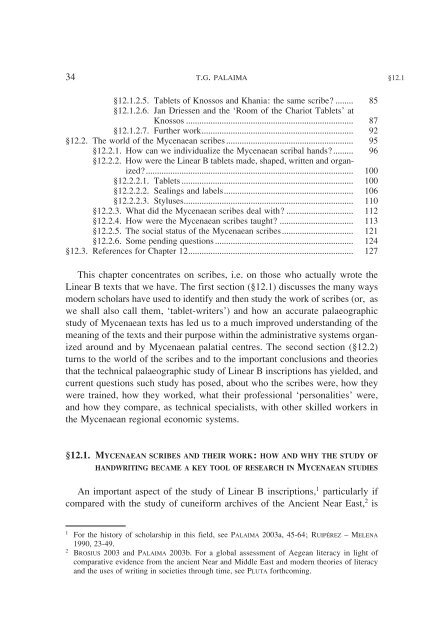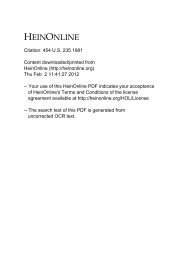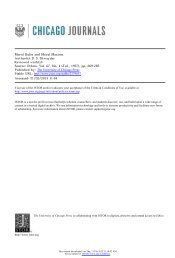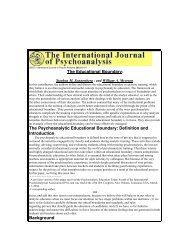A Companion to Linear B - The University of Texas at Austin
A Companion to Linear B - The University of Texas at Austin
A Companion to Linear B - The University of Texas at Austin
You also want an ePaper? Increase the reach of your titles
YUMPU automatically turns print PDFs into web optimized ePapers that Google loves.
34 T.G. PALAIMA §12.1<br />
§12.1.2.5. Tablets <strong>of</strong> Knossos and Khania: the same scribe? ........ 85<br />
§12.1.2.6. Jan Driessen and the ‘Room <strong>of</strong> the Chariot Tablets’ <strong>at</strong><br />
Knossos ........................................................................... 87<br />
§12.1.2.7. Further work .................................................................... 92<br />
§12.2. <strong>The</strong> world <strong>of</strong> the Mycenaean scribes ......................................................... 95<br />
§12.2.1. How can we individualize the Mycenaean scribal hands? ......... 96<br />
§12.2.2. How were the <strong>Linear</strong> B tablets made, shaped, written and organized?<br />
............................................................................................. 100<br />
§12.2.2.1. Tablets ............................................................................. 100<br />
§12.2.2.2. Sealings and labels .......................................................... 106<br />
§12.2.2.3. Styluses ............................................................................ 110<br />
§12.2.3. Wh<strong>at</strong> did the Mycenaean scribes deal with? .............................. 112<br />
§12.2.4. How were the Mycenaean scribes taught? ................................. 113<br />
§12.2.5. <strong>The</strong> social st<strong>at</strong>us <strong>of</strong> the Mycenaean scribes ................................ 121<br />
§12.2.6. Some pending questions .............................................................. 124<br />
§12.3. References for Chapter 12 .......................................................................... 127<br />
This chapter concentr<strong>at</strong>es on scribes, i.e. on those who actually wrote the<br />
<strong>Linear</strong> B texts th<strong>at</strong> we have. <strong>The</strong> first section (§12.1) discusses the many ways<br />
modern scholars have used <strong>to</strong> identify and then study the work <strong>of</strong> scribes (or, as<br />
we shall also call them, ‘tablet-writers’) and how an accur<strong>at</strong>e palaeographic<br />
study <strong>of</strong> Mycenaean texts has led us <strong>to</strong> a much improved understanding <strong>of</strong> the<br />
meaning <strong>of</strong> the texts and their purpose within the administr<strong>at</strong>ive systems organized<br />
around and by Mycenaean pal<strong>at</strong>ial centres. <strong>The</strong> second section (§12.2)<br />
turns <strong>to</strong> the world <strong>of</strong> the scribes and <strong>to</strong> the important conclusions and theories<br />
th<strong>at</strong> the technical palaeographic study <strong>of</strong> <strong>Linear</strong> B inscriptions has yielded, and<br />
current questions such study has posed, about who the scribes were, how they<br />
were trained, how they worked, wh<strong>at</strong> their pr<strong>of</strong>essional ‘personalities’ were,<br />
and how they compare, as technical specialists, with other skilled workers in<br />
the Mycenaean regional economic systems.<br />
§12.1. MYCENAEAN SCRIBES AND THEIR WORK: HOW AND WHY THE STUDY OF<br />
HANDWRITING BECAME A KEY TOOL OF RESEARCH IN MYCENAEAN STUDIES<br />
An important aspect <strong>of</strong> the study <strong>of</strong> <strong>Linear</strong> B inscriptions, 1 particularly if<br />
compared with the study <strong>of</strong> cuneiform archives <strong>of</strong> the Ancient Near East, 2 is<br />
1 For the his<strong>to</strong>ry <strong>of</strong> scholarship in this field, see PALAIMA 2003a, 45-64; RUIPÉREZ – MELENA<br />
1990, 23-49.<br />
2<br />
BROSIUS 2003 and PALAIMA 2003b. For a global assessment <strong>of</strong> Aegean literacy in light <strong>of</strong><br />
compar<strong>at</strong>ive evidence from the ancient Near and Middle East and modern theories <strong>of</strong> literacy<br />
and the uses <strong>of</strong> writing in societies through time, see PLUTA forthcoming.

















